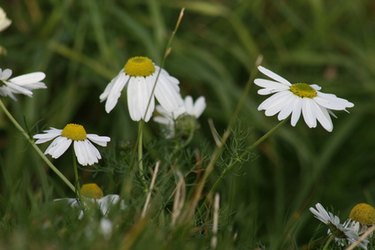
Even if you plant, water and feed your plants regularly, they will still need to have their wilted blooms removed to ensure their health. This process is called deadheading, and flowers that are grown in the casual garden style, like daisies, benefit when this is done. It is easy to do and will make your plants stronger. Even better, plants that undergo deadheading will yield more flowers in the long run.
Perennial Daisy Types
Video of the Day
Cottage gardens are styled after English cottage gardening styles, and the flowers are planted and designed to grow in more casual ways along arbors, fences and pathways. Flowers are the main focus and will thrive with the right kind of deadheading. Cottage garden plants that need this maintenance may include daisies.
Video of the Day
The perennial Shasta daisy (Leucanthemum × superbum, USDA plant hardiness zones 4 to 9) is a favorite of gardeners. These plants are easy to care for and bloom in the mid to late summer. The plants grow up to 36 inches tall and are resistant to diseases and pests. Foxgloves (Digitalis, USDA plant hardiness zones 3 to 9) are another great choice, and they produce purple, pink, peach, white or yellow flowers. These only bloom every other year, though, and they are toxic to pets and children.
Peonies (Paeonia, USDA plant hardiness zones 3 to 8) bloom in the late spring. They have oversized blooms and smell lovely. These hardy perennials come back year after year. Another great choice are bellflowers (Campanula, USDA plant hardiness zones 3 to 8 depending on species), which flower in midsummer. These can grow up to 5 feet tall with flowers in white, violet, purple or pink.
Basics of Deadheading Daisies
Shasta daisies grow in clumps, and regular deadheading will extend their blooming season. It is best to do this before the flowers are completely dead. Keep an eye on the plants and when you see flowers starting to fade or wilt, you can get out your (clean) gardening shears. The best time to do so is before the flowers die back completely. If you see the flowers begin to fade, wilt or become brown, it's time to deadhead your plants.
Cut the flowers using sharp gardening shears for best results rather than pulling and pinching. Try removing the flower stems just below the wilted flowers and above the healthy leaves. You can also pinch off the spent flowers, but working with shears can be quicker.
Additional Deadheading Tips
Be sure to also remove any seed pods that have formed behind the wilted blooms. The stems can be cut all the way to the bottom without harming the plant. It should grow back and flower again.
Also, be sure to save all the debris after the process of deadheading and dispose of it properly. Leaving it around the plants can create a breeding ground for pests and diseases. You may have a compost pile; this is a great place to situate flowers you've removed from plants.
If you have or plan to set up a larger cottage garden or other garden, take heart: Other types of flowering cottage garden plants can be deadheaded in much the same way as Shasta daisies. This will lead to a vibrant, healthy garden with many blooms.